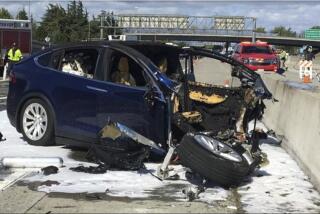Personal Robot of the Future Today
- Share via
Want another cold one?
Don’t get up.
For the record:
12:00 a.m. May 25, 2002 For The Record
Los Angeles Times Saturday May 25, 2002 Home Edition Main News Part A Page 2 National Desk 6 inches; 238 words Type of Material: Correction
Evolution Robotics--A caption accompanying a photo of Idealab’s Bill Gross and Evolution Robotics’ Bernard Louvat incorrectly identified each as the other in Friday’s Business section.
Just show the ER1 robot--essentially a laptop on wheels--an empty bottle and it can scoot across the room and pick out a Heineken from among cans of Coke and Mountain Dew.
After grabbing the beer in its mechanical claw, the 2-foot-tall ER1 returns with the brew and a pleasant “Here you go.”
Since the dawn of the Industrial Age, humans have dreamed of intelligent machines to attend to mundane chores. Industrial robots have assembled cars for years, putting the same weld in the same spot hundreds of times a day.
But household robots such as Rosey from “The Jetsons” have been difficult to develop because the average three-bedroom house is infinitely more chaotic than the controlled environs of a factory floor.
The $500 ER1, developed by Pasadena-based Evolution Robotics and unveiled this week at the Electronics Entertainment Expo, looks and acts more like personal robots of the future: “Much more mundane, much more useful and much more simple,” said Bill Gross, chief executive of Idealab, the high-tech incubator that spun off Evolution this year.
Capable of performing 99 distinct behaviors, the ER1 can grab things from the kitchen, greet visitors at the front door, find car keys and snap photographs of the baby-sitter. Unlike other personal robots such as Sony’s AIBO dog, the ER1 is the first mass-produced automaton to perform at least nominally helpful tasks.
Experts say Evolution Robotics may do for the personal robot what Microsoft did for the personal computer by setting a standard operating environment in which others can innovate. The company expects early adopters and hobbyists to develop applications for the robot, much as software developers did for the first personal computers. Once Evolution Robotics determines how people use the robots, the company plans to release models pre-programmed for specific purposes--such as security or elderly care--later this year.
The personal computer eventually found its place in the home and office, but it is uncertain if the personal robot will be as welcome. Unlike a PC, which can perform multiple tasks, individual robots probably will have specific purposes. Even with recent advances in processing power, sensors and object-recognition systems that have improved robotic capabilities, designing a machine capable of completing even a relatively modest list of diverse chores is prohibitively complex.
“I don’t think there’s a concept of a general-purpose robot for the home, just like there is for the general-purpose computer,” said Jean-Claude Latombe, director of the Stanford Robotics Laboratory. So one machine might mow the lawn, another would vacuum the living room floor and a third would clean the kitchen.
“The idea is not one single butler, but you can think of it as an army of little butlers,” said Maja Mataric, director of the USC Robotics Research Laboratories and a member of Evolution Robotics’ scientific advisory board.
Over time, applications may become more complicated. Robots that teach children could read facial expressions to determine a child’s comprehension. Others could remind users to pick up milk from the store on the way home from work.
The first versions of ER1 are geared toward hobbyists, the same sort of gear-heads who snapped up Lego’s Mindstorms robot kits.
The ER1 is essentially a metal box with a camera on wheels. Users attach a laptop. The software’s graphic interface, which displays the view from the robot’s camera, allows users to program the robot directly on the laptop or, with a wireless connection, on a remote computer.
Users select one of five “if” conditions--such as sight, sound and time--and assign it a corresponding response: move, play a sound, run a program, send a message or record. If, for instance, a robot hears, “Bring me a beer,” it could be programmed to find a beer and return it to the user.
Evolution Robotics created its own object-recognition system that enables robots to identify human faces. The robot also can recognize voices. Peripherals--an arm, “skin” cover and charger to which the robot can be programmed to routinely connect--will eventually be available.
Evolution Robotics also sells more sophisticated kits that allow engineers to build custom robots. Evolution Robotics President Bernard Louvat calls the kits, which sell for between $1,500 and $10,000, “Lego Mindstorms on steroids.”
The developer kits require basic programming knowledge of C++ and Linux.
One of the company’s custom robots--called Ultrabot--can follow a person walking in front of it. Another moves according to voice commands. The computer-generated face on its laptop screen frowns when it bumps into obstacles and smiles when it successfully accomplishes its task. A third robot identifies a book, box of cereal and $1 bill.
After watching an Evolution Robotics demonstration Thursday, Darryl Williams said he hoped such robots would perform additional tasks in the future. But for some people, he pointed out, the ability to get refills without leaving the couch--and missing the game--may be enough.
“Maybe after a couple of years of getting beers it pays for itself and you’re happy.”






